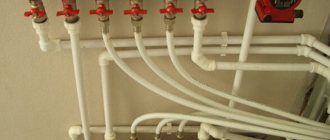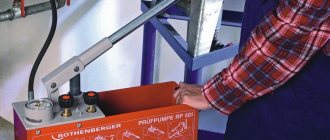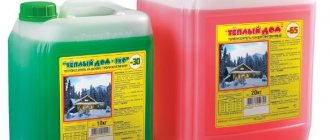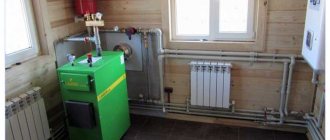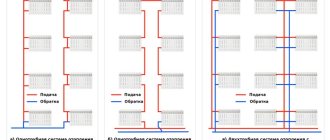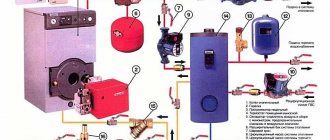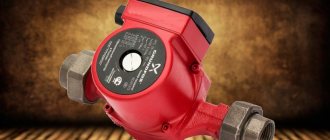The principle of operation of antifreeze
Water at 0°C abruptly and abruptly turns into ice, expanding by 11%. The pipes cannot withstand such a load. The heating system has to be dismantled, including the boiler and all radiators. Water is a good solvent, so even a small amount of antifreeze greatly shifts the crystallization point of water, and abrupt transformation into ice does not occur.
At subzero temperatures, water with the addition of antifreeze slowly thickens, and the liquid expands slightly, so the heating system remains safe and sound.
For example, the crystallization of water with 30% antifreeze liquid (propylene glycol) is so slow that there is no need to dilute the coolant to -30°C; it is enough to add antifreeze to the design temperature of -12-15°C. As the temperature drops below the calculated value, such a mixture will slowly but surely harden, and only at -30°C can it freeze completely.
Which coolant should I choose for heating?
For a heating system, the differences between ethylene glycol and propylene glycol are insignificant, but different freezing temperatures (-70 and -50 ° C) affect the percentage of the substance. To ensure the same crystallization temperature (-25°C), almost 2 times less ethylene glycol is required than propylene glycol, but the relationship is not linear.
For example, when the concentration of ethylene glycol in water becomes more than 50%, its characteristics begin to decline. This is due to the ineffective operation of anti-corrosion additives, which do not come into contact with water well.
Which antifreeze is best for heating a home?
The main criterion for choosing antifreeze is safety!
Propylene glycol is used in the food industry. The substance is not toxic. It is used as antifreeze in heating systems of cottages, country houses and premises with constant occupancy.
If the building does not require environmental safety, for example, warehouses, garages and production workshops, you can safely use ethylene glycol. In all other cases - propylene glycol.
Additional recommendations for use
If you decide to dilute the coolant with water from a well or well, where a high content of metals and salts may be noted, you should mix the product with water in a transparent container. It is important to maintain the required proportion. Once you are sure that there is no sediment, you can mix in the required volumes to fill the heating system.
This can be done before pouring the product into the system, which is especially true for systems that operate on the principle of natural circulation. As an alternative solution, a technology is sometimes used in which the filling occurs alternately, while the coolant can be prepared in separate small portions.
Glycerin in the heating system
I received a lot of questions about “glycerin”. Glycerin-based coolant in the heating system is unacceptable even in a diluted state.
Firstly, monstrous kinematic viscosity at negative temperatures (at 0°C -9000 m2/s x 106 - glycerin, 67 m2/s x 106 - ethylene glycol) - and therefore monstrous pressure losses. It will be difficult to push glycerin-based coolant through the pipes.
Secondly, the adhesion of organic glycerin particles to the surface of the boiler heat exchanger, its overheating and complete failure. Diluting glycerin with alcohols only leads to the formation of explosive compounds.
Any other non-freezing liquids, for example, antifreeze in the heating system, are unacceptable, because do not contain the required amount of anti-corrosion additives. The cost of antifreeze for heating is determined by the quality of these same additives, thanks to which some antifreezes last 5 years and others 10. Over the years, the antifreeze in the heating system oxidizes to form acetic acid, which leads to the destruction of brass connections on radiators, so it is important to change the coolant on time.
About types of coolants
Ethylene glycol based coolant
Formula of the main substance: C2H6O2.
It is often called: glycol, 1,2-ethanediol, MEG, monoethylene glycol, dioxyethane.
In general, it is a dihydric alcohol that looks like an oily liquid without a distinct odor or color. The taste is slightly sweet. In industry, it is produced by temperature or catalytic hydration of ethylene oxide.
Disadvantages and advantages
|
|
Graph of the beginning of crystallization of an ethylene glycol solution
The figure shows the dependence of the freezing temperature on the content of the main substance in the water solution. The values may differ from the table ones, since they indicate the beginning of the formation of crystals, and not the complete completion of the process.
By clicking on the picture on your desktop or pointing your finger on your phone, you can enlarge it.
Propylene glycol based coolant
The formula of the main substance is C3H8O2.
Also called propanediol-1,2.
The liquid is a transparent, colorless substance without a distinct odor with a sweetish taste. Its density is lower than glycerin and ethylene glycol.
The main method of production is the hydration of propylene oxide.
Disadvantages and advantages
|
|
Graph of the beginning of crystallization of a propylene glycol solution
The diagram shows the dependence of the freezing temperature on the content of the main substance in the water solution. As before, the data may differ from the tabular ones, since they show the beginning of the formation of crystals, and not the complete completion of the process.
By selecting an image, you can enlarge it for a more detailed look.
A common drawback of all glycol coolants is the requirement for replacement or regeneration after 5-7 years.
At the end of the warranty period, they must be inspected and based on the inspection, either they can continue to be used or replaced/refurbished.
Glycerin based coolant
The formula of the main substance is C3H5(OH)3
Also called glycerol, propanetriol-1,2,3.
This is the simplest version of trihydric alcohols and is a non-toxic, viscous, transparent liquid with a sweet taste.
It is produced in completely different ways, of which the most ancient is through hydrolysis (saponification) of fats.
|
|
Graph of the beginning of crystallization of a glycerol solution
The diagram shows the dependence of the crystallization temperature on the content of the main substance in the water solution.
By selecting an image, you can enlarge it for a more detailed look.
Our choice
Since the main sector of buyers who are wondering about choosing the type of coolant are “private owners,” we would recommend using a propylene glycol-based antifreeze. Currently, in the structure of the cost of operating houses, the price of the coolant will not be considered key, and the advantages of the choice are obvious.
With increased safety requirements, we would recommend a glycerin-based option, but with the condition of increased control over the functioning of the heating system without allowing the operating temperature to exceed.
Ethylene glycol can be used for the preservation of air conditioning systems or at industrial facilities.
Thus, before buying a heating fluid, we recommend that you weigh everything and make a decision.
Please note that even within the same type of solution, additives of different types can be used: organic (silicate) and non-organic (carboxylate), which affect the overall service life. It is believed that, on average, with the first type of additive the service life is up to 5 years, and with the second - up to 10 years.
In addition, there are separately sold products that more effectively solve certain problems of operating systems. They must be used according to the manufacturers' instructions.
These include:
- Leak sealers - allow you to eliminate leaks;
- Corrosion inhibitors - additional protection;
- Reagents for cleaning heating systems.
Heating with antifreeze or water
After reading this section, you will most likely refuse antifreeze in your heating system. The main advantage of antifreeze - the safety of the system at subzero temperatures - is completely negated by its disadvantages.
- Low heat capacity of antifreeze. Increasing the size of radiators by 20-23%
The heat capacity of antifreeze is significantly lower than the heat capacity of water. By diluting water with 35% antifreeze, we lose approximately 200 W per 1 kW of thermal energy. This means that the size of pipes, radiators and boiler must be increased by 20%. In terms of a country house of 300 m2, we lose approximately 60 thousand rubles by increasing the size of the system.
- The service life of antifreeze is from 5 to 10 years. Over the years, antifreeze oxidizes and successfully destroys brass connections. After 5 - 10 years, ethylene glycol and propylene glycol must be drained, disposed of and replaced with a new one. You will not only have to buy new antifreeze, but also pay to dispose of the old one. Unfortunately, in our country there is no service for recycling ethylene glycol in small volumes, so finding someone to hand over this chemical to will be difficult. I won’t consider the idea of dumping antifreeze on my neighbor’s property.
- The use of sectional radiators in systems with antifreeze is unacceptable. Rubber sectional gaskets quickly oxidize, and the radiators leak. We use only steel panels. The use of galvanized pipes is also unacceptable. Antifreeze safely washes away the zinc, and the pipe remains bare.
- Why is antifreeze useless for a country house? Antifreeze will successfully cope with the task - the heating system will not freeze in winter in your absence, but what to do with the water supply system? At subzero temperatures, water supply pipes will freeze faster and with worse consequences, because... laid not only in the floor, but also in the walls. You will have to remove the tiles, beat the screed and change the pipes in the bathrooms, showers, kitchen, and replace the entire water supply system of the boiler room. Of course, it will not be possible to pump antifreeze into the water supply system, nor will it be possible to lay all the pipes with heating cables.
Conclusion: Antifreezes are suitable either for heating small country houses for temporary residence, or large warehouses, workshops and enterprises. In the heating system of a full-fledged country house, antifreeze is useless.
Antifreeze for the heating system of a country house is needed if: ✔ you do not plan to live in the house in winter; ✔ the house has 1-2 bathrooms with a tee water supply system (without a collector), which can be drained before the onset of cold weather.
It is impossible to leave a full-fledged country house in winter without heating on duty. In winter, it is necessary to maintain constant standby heating +10-12°C.
The boiler can be controlled remotely via a phone or tablet via an Internet connection or GPS. You can set the air temperature for a specific date and time of arrival, and the boiler will accurately signal possible errors in operation. To maintain the heating system in the event of a failure of the main boiler, a backup electric boiler is often installed, which also turns on automatically. You can order a project for such a boiler room and heating system from us on the Services page.
This way your engineering systems will be truly protected without antifreeze.
If you liked my article and are looking for reliable design specialists, call or email me.
Sometimes the heating system stops functioning at the height of the heating season. The reasons can be different, from a power outage to a breakdown of any element of the system. If water is used as a coolant, then the lack of heating for a certain amount of time (including depending on the insulation of the house) leads to defrosting of the heating system. Defrosting, as a rule, leads to sad consequences, such as burst pipes, radiators, etc. However, this can be avoided if antifreeze is used as the coolant.
Thermagent Eko coolant, 10 kg.
Antifreeze for a heating system is a liquid whose main purpose is to protect the system from defrosting, as well as reduce the effects of corrosion, scale and various microorganisms.
Note! Manufacturers add special additives to the coolant that prevent the formation of corrosion and scale. However, it should be noted that the effect of additives, as a rule, lasts for a maximum of 5-6 years, after which their effectiveness is greatly reduced and the coolant, while maintaining its anti-freezing properties, will no longer protect the system from the effects of corrosion and scale. After 5-6 years, it is recommended to fill in a new coolant, while first flushing the system with water.
Hot Stream-65, 47 kg. Up to -65°C.
Blitz tips
If you dilute the coolant with water from a well or well, which contains a lot of minerals, then it is advisable to dilute the mixture in a transparent container in order to notice the formation of sediment in time. Considering that in some regions the water is of very low quality, it is advisable in this case to use completely ready-made formulations.
Not recommended:
- Fill galvanized systems because sediment may form from the coolant as a result of a chemical reaction;
- Use the composition in heating with electrolysis boilers;
- Mixing “Warm House” with similar products may cause a decrease in performance properties and service life;
- Overheat the coolant.
The compositions “Warm House -30” and “Warm House -65” are produced only for technical purposes (it contains poisonous ethylene glycol). To prevent poisoning, this composition should not be allowed to get into drinking water or food. If it gets on the skin, the area must be washed well with soapy water.
"Warm House-ECO" is suitable as a refrigerant in food production. But this does not mean at all that, for example, you can drink it. All types of coolant are explosion-proof and do not support combustion.
If necessary, the coolant must be stored in an airtight container, inaccessible and protected from sunlight; they should not be placed near food products.
The coolant "Warm House - 65" is produced on the basis of domestic high-quality ethylene glycol (colored red). It is intended for various heating and air conditioning systems as a working fluid, ensuring operation in the range from – 65°C to 112°C (in accordance with the instructions for operating the equipment).
A specially selected package of additives reliably protects against scale, foaming and corrosion, does not have an aggressive effect on plastic and metal-plastic, rubber, paranit and flax, i.e. the possibility of leaks is excluded. As an exception, its use in systems with galvanized pipes is undesirable, because precipitation is possible. However, you should know that it has a slightly higher fluidity than water, so it is necessary to carefully assemble all the connecting units and be sure to carry out preliminary pressure testing of the system. If necessary, joints in systems can be treated with sealants resistant to glycol mixtures (Hermesil, ABRO, LOCTITE), and silky flax can be used without smearing with oil paint.
“Warm House - 65” cannot be used for electrolysis boilers (type “Galan”). The coolant for electrolysis boilers must have a certain electrical resistance, for which it is saturated with salts. But this worsens all other parameters for protection against corrosion and scale, so the developers of “Warm House” refused to create a joint universal recipe.
The coolant "Warm House - 65" is highly stable and ensures continuous operation for five years. To obtain the working mixture at the required temperature for the start of crystallization, the “Warm House - 65” coolant is diluted with distilled or ordinary tap water:
It should be taken into account that at the indicated temperatures the crystallization process is just beginning, and its thickening occurs when it is lowered by about 8°C. Destruction of the system is excluded, since the coolant does not expand.
It is imperative to dilute “Warm House -65” with water! This allows you to increase the heat capacity and reduce the viscosity of the coolant, i.e. improve its circulation. The optimal dilution of the coolant is -25° - -30°C, for electric and gas boilers - at -20°C. Using a mixture with a lower crystallization onset temperature can lead to ethylene glycol deposits on heating elements or in the burner area, which will lead to the formation of tarry deposits, burnout of heating elements, etc.
If water from wells, boreholes, etc., where there may be a high content of salts and metals, is used to dilute the coolant, it is recommended to first mix the coolant with water in the required proportion in a transparent container and make sure there is no sediment. Mixing the coolant with water can be done immediately before pouring into the system (especially for systems with natural circulation) or by filling it alternately in small portions.
Properties of non-freezing liquid, which lead to an increase in the cost of the heating system
- Increased viscosity. The viscosity of antifreeze-based coolant is 3-5 times higher than that of water. Therefore, the performance of the circulation pump should be 10-15% more.
- Low heat capacity. The heat capacity of antifreeze can be up to 15% lower than that of water; this should be remembered when choosing heating devices. Radiators or other heating devices should be 15-20% more powerful.
- High turnover. This property of antifreeze places increased demands on the installation of the heating system. If possible, make as few connections as possible to reduce the risk of leaks. For example, if you plan to use a homemade distribution manifold in the heating system, then it is recommended to use polypropylene tees for its assembly. High-quality soldering virtually eliminates leakage of such a collector. On the contrary, it is not recommended to make a manifold from steel tees connected by nipples; a large number of connections increases the likelihood of leakage. As a last resort, all manifold connections can be sealed with anaerobic sealant. Also a prerequisite in the case of using antifreeze is to carry out a pressure test of the system.
Homemade distribution manifold made of polypropylene tees.
Thus, the use of antifreeze for the heating system of a country house leads to an increase in its cost, because it is necessary to install radiators with a larger number of sections, as well as a more efficient circulation pump.
Note! In addition to all of the above, it is always necessary to have an additional supply of antifreeze in case the heating system fails, when part of the coolant has to be drained to carry out repair work.
When producing high-quality coolants, special additives are added to the liquid, which protect the system from corrosion and scale, and also reduce the formation of microbubbles.
Questions and answers about the coolant “Warm House”
Why is coolant needed - antifreeze?
The main task of the “Warm House” coolant is to prevent the destruction of heating and air conditioning systems as a result of defrosting, as well as to protect them from the formation of corrosion and scale, which leads to a sharp deterioration in heat transfer and an increase in energy consumption, and subsequently to failure. In reality, the “Warm Home” TN is used very widely. Naturally, both in individual systems of small buildings and cottages, and in heating networks of multi-storey buildings, entire villages, industrial and commercial facilities, in systems of cold storage plants and storage facilities, for sports facilities (skating rinks and football fields).
In which boilers is the “Warm House” heating element used?
TN “Warm House” is suitable for all types of boilers, except electrolysis ones (type “Galan”). There, the VT must have a certain electrical resistance, for which it is saturated with salts. But this worsens all other parameters for protection against corrosion and scale, so the developers of “Warm House” refused to create a joint universal recipe.
What is the difference between TN “Warm House” and antifreeze?
Most antifreezes contain nitrites, amines, phosphate and silicate compounds, which form fumes harmful to humans and animals. They have a limited service life (2-3 years). In addition, antifreezes are not designed for dilution at all, especially with tap water. TN “Warm House” is approved for use in residential premises, and “Warm House - Eco” can be used in the food industry. They are diluted with ordinary tap water to -20C, as they contain more powerful additives. Service life – at least 5 years.
What is the difference between the “Warm House” HP and other coolants?
The thermal and physical characteristics of all glycol-based coolants, regardless of color, are absolutely the same (if, of course, they are produced without violating the technology). Their main difference lies in the formulation of the additive package, which must withstand dilution with hard water and protect systems from corrosion, scale and foaming for a long time. TN “Warm House” has passed the test of quality and time: most leading companies in the field of heating and heating equipment have chosen in its favor. Antifreeze manufacturer - KhimAvto Group of Companies - one of the largest in Russia. Our own modern plant, stable operation, well-known product brands, low cost, prompt delivery, favorable working conditions for wholesalers - these are the basis for successful promotion in the market.
Is it possible to use an aqueous solution of ethylene glycol (MEG) as a coolant?
This solution, of course, will always be low-freezing. The temperature will depend on the percentage of MEG: at – 30C it needs 45%, and at – 20C – 36%. But without additives, such a solution is several times more corrosive than ordinary water. This is what the coolant, antifreeze, becomes after its additives have exhausted their service life. The manufacturer provides a 5-year warranty on the “Warm House” TN.
Where is it advisable to use TN “Warm House-Eco”?
This antifreeze is prepared on the basis of imported pharmacological propylene glycol, therefore it is harmless to people. It can be used without restrictions in any heating and air conditioning systems, especially in double-circuit boilers, as well as in facilities with increased environmental safety requirements.
Is it possible to mix different coolants?
It is not recommended to mix any antifreeze without first checking for compatibility. If the chemical bases of TN additive packages are different, this can lead to their partial destruction and, as a consequence, to a decrease in anti-corrosion properties. TN “Warm House” is fully compatible with TN “Gulfstream”, the most common in the North-West region, but it is not advisable to mix it with TN “Dixis”, which has a phosphate base.
Is it necessary to dilute the “Warm House-65” coolant?
Necessarily! Since diluting the heating element with water, in addition to saving money for the consumer, allows you to increase heat transfer, reduce the density of the mixture and improve its circulation through the system. The likelihood of carbon deposits on heating elements or in the area of burners and the penetrating ability of antifreeze, which is significantly higher than that of water, are also reduced. It is considered optimal for the Central region to dilute the heating element by - 25-30C, for electric boilers by - 20-25C. Even if the temperature drops below the specified parameters, destruction of the system is excluded, since the HP does not expand. It turns only into a jelly-like mass, which becomes liquid again when the temperature rises.
What water is best to dilute the coolant?
Ideally, it is better to dilute TN with distilled water, which does not contain calcium and magnesium salts, since they crystallize when heated and form scale. For example, scale 3mm thick reduces heat transfer by 25% and the system will require large energy consumption. TN “Warm House” contains a special additive that ensures normal operation when diluted with ordinary tap water (no more than 5 units of hardness). For information: water from a well, if a softening system is not provided, may have a hardness of 15-20 units.
Is it possible to use “Warm House” in systems with galvanized pipes?
Any glycol-based antifreeze coolant, including imported ones, cannot protect galvanized coatings. Possible problems (metallized suspension, and then poorly soluble sediments) depend on the volume of such distribution. However, you should know that even hot water (over 70C) also washes away zinc, albeit much more slowly.
What is best to use to seal connections?
You can use sealants that are resistant to glycol mixtures (for example, Hermesil, LOCTITE and ABRO) or silky linen, but without smearing with oil paint.
Are there any mandatory rules that should be taken into account when designing a system if it will operate on coolant?
Since glycol-based HPs are more viscous, it is necessary to install circulation pumps that are more powerful than when working on water (by 10% in productivity, by 50-60% in pressure). When choosing an expansion tank, it should be taken into account that the coefficient of volumetric expansion of the “Warm House” HP (as well as other coolants) is 15 - 20% greater than with water (water - 4.4 * 10-4, and a mixture of HP and water: by – 20С – 4.9*10-4, at – 30С – 5.3*10-4). As a conclusion: the expansion tank should not be less than 15% of the system volume. The maximum thermal power of the boiler when operating on a HP will be approximately 80% of its nominal value.
Can the coolant cause air in the system?
TN “Warm House” in no way affects the formation of voids filled with oxygen or gas formations. The reasons should be sought in errors in the design or installation of equipment: a small expansion tank, the galvanic effect of incompatible elements, incorrectly selected installation locations for air vents, incorrect settings of thermostats, etc.
What does overheating of the “Warm House” HP lead to and how to avoid it?
With prolonged overheating, thermal decomposition of additives and the glycol itself begins. TN becomes dark brown, an unpleasant odor appears, and precipitation forms. Often carbon deposits form on heating elements, which causes them to fail. In order to prevent carbon deposits, it is necessary: – when diluting TN, there is no need to “chase” the freezing temperature, optimally prepared solutions should be at – 20 – – 25ºС; maximum – 30ºС; – install a more powerful circulation pump; – limit the temperature of the heat pump at the boiler outlet to 90ºС, and for wall-mounted ones – 70ºС; – in the cold season, heat the HP gradually, without turning on the boiler at full power.
How does non-freezing liquid work for the heating system of a private home?
Unlike water coolant, which begins to freeze already at 0°C, antifreeze for the heating system begins to freeze at lower temperatures, from -13°C to -60°C (depending on the antifreeze used and the degree of its dilution), while freezing happens gradually. As the liquid cools, crystals appear in it (the process of crystallization), then with a further decrease in temperature, more and more crystals appear and only when a certain freezing temperature is reached does the liquid completely solidify.
Water for heating systems with Hot Stream corrosion inhibitor. Ingredients: demineralized water, Arteco additive package (Belgium). .
Unlike water (which expands greatly when freezing, and a rupture occurs somewhere), a non-freezing liquid practically does not expand in volume (about 0.1-1.5%), which eliminates the possibility of a rupture of the system.
Recommendations for diluting refrigerant with water
The cooling system is an important element of the overall design of the car. Monitoring its serviceability is as important as monitoring the condition of the engine or the oil level in the engine. If there is a need to add water to antifreeze, then this must be done according to the rules in order to avoid unnecessarily negative consequences for the car.
In particular, the following recommendations can be highlighted:
- Do not add regular tap water to antifreeze. The liquid has a complex chemical composition, can quickly form sediment and cause damage to cooling systems. You can use tap water only as a last resort, but as soon as possible, head to a service station or do the flushing yourself.
- The best option may be to use a distillate. There is no need to make any special calculations regarding proportions. In summer the proportion will be 1:1, and in winter 7:3. You need to proceed from the fact that the higher the concentration of antifreeze, the less it freezes.
- A special need for topping up coolant arises in the summer, since the liquid evaporates quickly. In winter, you should not pour water into the system, since at -15 – 20 degrees, starting the engine will be almost impossible.
Controversy remains regarding whether antifreeze can be added under special circumstances. Many experts are inclined to believe that it is better to completely remove antifreeze from the system and simply pour distillate into it. For some time, this product will be able to replace technical fluid.
Antifreeze base
Various substances can be used as a basis for the manufacture of antifreeze. The most common are ethylene glycol, propylene glycol, glycerin and alcohol.
Ethylene glycol based coolant
Today, ethylene glycol-based antifreeze is the most common non-freezing coolant used in heating systems of private homes. However, it is quickly being replaced by more advanced and environmentally friendly propylene glycol antifreeze.
Ethylene glycol reliably protects the system from freezing. When the freezing temperature is exceeded, the coolant expands by 1.5-2%, which is not enough to cause a rupture in any part of the system.
Important! It must be remembered that ethylene glycol-based coolant is poisonous and can pose a danger to human health and life. During operation, it is recommended to completely exclude its contact with humans. In particular, this applies to heating systems with natural circulation, which have
open expansion tank
. An open-type tank must be installed in the attic, but not in a living space. As a last resort, you should make a gas outlet pipe from the tank, which will discharge dangerous fumes to the street.
When working with ethylene glycol, precautions must be taken, in particular wearing goggles and rubber gloves. Ethylene glycol can penetrate the human body through the skin, therefore, if during repair work or filling the system the antifreeze liquid gets on the skin, you should immediately wash it off with warm water and soap. If ingested, rinse the stomach and immediately go to the hospital or call an ambulance. It must be remembered that a 100-200 ml dose of ethylene glycol-based antifreeze entering the human body can be fatal. Lethargy and depression are obvious symptoms indicating poisoning.
Hot Stream, 20 kg - concentrated antifreeze for the heating system of a country house.
Ethylene glycol is not recommended for use with double-circuit boilers, because Antifreeze may enter the hot water supply circuit.
Storage should be carried out in a tightly closed container away from direct sunlight, electrical heating devices and food. It is highly not recommended to use ethylene glycol-based coolant in heating systems of houses where small children live, because the liquid has a sweetish taste and does not have an unpleasant odor, so small children will not be able to determine that it is poison, but on the contrary, they may think that it is some kind of juice or just sweet water!
Important! If a coolant leak occurs, then all objects on which ethylene glycol has fallen or been absorbed (tiles, linoleum, parquet, furniture,
decorative radiator screens
etc.) must be subject to mandatory replacement. Otherwise, they will be a constant source of toxic fumes.
Spent ethylene glycol antifreeze must be processed at specialized enterprises; it is prohibited to discharge it into sewers or soil.
Propylene glycol based coolant
Due to its relative harmlessness, antifreeze based on propylene glycol is used in facilities with high environmental requirements, where there is a possibility of the coolant getting into tap water or other human objects. As noted above, propylene glycol antifreezes, despite their higher cost, are gradually replacing non-environmental ethylene glycol antifreezes.
Propylene glycol antifreeze has been used as a coolant for heating systems since the 60s of the last century. However, only from the mid-90s, Western European countries, the USA and Canada began to completely switch to propylene glycol. Currently, Russia is also gradually switching to this safe antifreeze.
The coolant based on propylene glycol has a high viscosity, which nevertheless does not affect the hydraulic characteristics of the heating system. The fact is that propylene glycol has “lubricating properties” that compensate for its high viscosity.
The density of propylene glycol coolant is lower than the density of ethylene glycol, which reduces the load on the circulation pump and also ensures more efficient circulation of liquid through the heating system.
In addition, if propylene glycol-based antifreeze leaks, there is no need to replace all “contaminated” items. It is enough just to remove the coolant from the surface of objects and wipe them with a wet cloth.
Compared to ethylene glycol, propylene glycol more reliably protects the heating system from defrosting. Even if the minimum temperature is exceeded, propylene glycol antifreeze does not freeze, but turns into a mushy liquid, expanding by only 0.1%. With such a volume of expansion, rupture of the system is impossible.
The only drawback of this antifreeze is its high cost.
Hot Stream, 10 kg. The temperature at which crystallization begins is -30°C. Ingredients: ethylene glycol, demineralized water, Arteco additive package (Belgium). .
Glycerin based coolant
Glycerin coolants became most widespread in the 20s of the last century. It was glycerin that became the basis for the first non-freezing coolants in the USSR, however, due to a number of significant shortcomings, by the beginning of the 40s, glycerin was practically no longer used in heating systems.
Their main disadvantages were poor fluidity and a high level of viscosity, as a result of which the pumps quickly failed. To solve this problem, they tried to use various additives, mainly poisonous methyl alcohol (methanol), which negatively affected the mental state of workers who had constant contact with it. In addition to the negative impact on human health, methanol boiled already at a temperature of 65 ° C, while evaporating, methanol sharply increased the viscosity of the liquid. In addition, strong foaming of glycerin leads to the fact that air is constantly circulating in the system, the system is airy.
Another disadvantage of glycerin-based coolant is that when it is heated for a long time, toxic substances are released, which cause accelerated corrosion of the metal elements of the heating system, as well as corrosion of sealing materials.
Currently, manufacturers of glycerin-based antifreeze (including those with the addition of methyl alcohol) get rid of the above-described disadvantages by adding special expensive additives. Their cost is much higher than the cost of additives for ethylene glycol and propylene glycol. Therefore, when choosing antifreeze for a heating system, you should take into account that the price of a high-quality glycerin coolant will always be higher than ethylene glycol or propylene glycol. If the situation is the opposite, this means only one thing: the seller is trying to sell low-quality antifreeze.
Thermagent Eko, 45 kg. Up to -30°C.
Coolant "Teply Dom 65" - concentrated non-freezing liquid for refrigeration supply
Concentrated heating coolant “Warm House -65” (TD-65)
is made from high-quality ethylene glycol and is intended for use as an antifreeze liquid (antifreeze) in various heating (cooling) and industrial air conditioning systems in the operating temperature range from -65°C to 112°C.
A special package of additives, consisting of 10 (ten) component substances, used in the coolant Teply Dom 65 , is designed to impart anti-corrosion, anti-foam and anti-foam properties to the coolant, as well as to stabilize the thermophysical properties over the entire operating temperature range.
The quality characteristics of “Warm House” coolants for air conditioning systems (cooling and heating) must comply with the requirements of GOST 28084-89 “Anti-freezing coolants”
and specifications developed on its basis.
Concentrated coolant Teply Dom 65
is produced using a combined package of anti-corrosion, anti-scale and anti-foam additives and is intended for the production of heating coolants
- aqueous solutions with a lower crystallization (freezing) temperature. Reducing the concentration of ethylene glycol (which also reduces the freezing temperature - the beginning of crystallization) allows you to increase the heat capacity and thermal conductivity of the solution, as well as significantly reduce the viscosity, thereby improving the circulation of the coolant in the system and significantly increasing the heat transfer of the system. The best thermophysical characteristics for the climatic zone of Central Russia have coolants manufactured at temperatures of the onset of crystallization of -25°C
and
-30°C
.
Concentrated coolant "Teply Dom 65" (TD-65) on ethylene glycol - non-freezing liquid for air conditioning and heating systems
(65% concentration, with anti-corrosion, anti-scale, anti-foam and stabilizing additives)
| Packaging, weight in kg | Temperature of the onset of crystallization (freezing), t°C | Sale / Price in rub./kg with VAT, when ordering up to 1 ton | Sale / Price in rub./kg with VAT, when ordering more than 1 ton |
| Canister 20 kg, Can 50 kg | minus -65°C | RUB 80.00/kg | depending on batch size |
Concentrated coolant "Teply Dom 65" (TD-65) on ethylene glycol - non-freezing liquid for air conditioning and heating systems
(65% concentration, with anti-corrosion, anti-scale, anti-foam and stabilizing additives)
| Packaging, weight in kg | Temperature of the onset of crystallization (freezing), t°C | Sale / Price in rub./kg with VAT, when ordering from 1 ton | Sale / Price in rub./kg with VAT, when ordering more than 2 tons |
| Barrel, 230 kg | minus -65°C | RUB 77.00/kg | depending on batch size |
Heating coolants with such thermophysical characteristics are guaranteed to protect the system from destruction in the event of an emergency shutdown, even at lower temperatures in the working premises and in the system itself, since ethylene glycol solutions crystallize into a jelly-like form. The use of coolants with a high concentration of ethylene glycol is more likely to lead to carbon deposits on the heating elements or in the burner area and the formation of tarry deposits and burnout of electric heating elements (heating elements).
To obtain an aqueous solution with the required operating temperature (temperature at which crystallization begins, freezing), the coolant “Warm House -65” (TD-65) should be diluted with distilled water or tap water with a total hardness of no more than 6 mEq/l in accordance with the table below:
Recipe-calculation for obtaining 100 liters of ready-made solution from the concentrated coolant “Teply Dom 65”:
| Coolant "Teply Dom 65", l | Water, l | Temperature of the beginning of freezing (crystallization), t°C |
| 77 liters | 23 liters | -40ºС |
| 65 liters | 35 liters | -30ºС |
| 60 liters | 40 liters | -25ºС |
| 54 liters | 46 liters | -20ºС |
To obtain any other amount of aqueous solution (according to the selected crystallization temperature and the corresponding values in the line!!!)
The values of coolant and water given in the table, in liters, are proportionally increased or decreased by the coefficient
K = V/100
, where V is the volume of the coolant solution being prepared, for example, if the volume
V
= 56 liters, then coefficient
K
= 0.56;
if the volume V
= 1559 liters, then the coefficient
K
= 15.59.
And you should also keep in mind that the coolant “Teply Dom 65” is bottled into canisters (barrels) in kilograms (by weight) and this must be taken into account when calculating: at a temperature of 20°C, 1 liter = 1.087 kg, 1 kg = 0.92 liters. Therefore, in order not to complicate calculations due to the influence of temperature on the density of the coolant, we recommend preparing the required solution at an ambient temperature close to 20ºC and performing all operations in volume fractions, in liters.
If water from wells, wells, etc., where there may be a high content of salts and metals, is used to dilute the coolant, then it is recommended to first mix a small volume of the Teply Dom 65 coolant with water in the required proportion in a transparent container and make sure there is no sediment. Mixing the coolant with water can be done immediately before pouring into the system (especially for systems with natural circulation) or by filling it alternately in small portions.
Coolants Teply Dom 65, thanks to complex additives, have high stability of thermophysical properties and ensure continuous operation for 5 years. After five years of operation, the coolant will remain a low-freezing liquid, but the resource of additives to counteract corrosion and scale will be exhausted. Therefore, the coolant must be drained and disposed of. Before filling in new coolant, the system must be flushed with a special liquid or water.
It should be borne in mind that the service life of the coolant depends on its operating conditions. We do not recommend:
- pour coolants into systems with galvanized pipes, as galvanizing may peel off and precipitation may occur;
- use coolants in heating systems with electrolysis boilers of the “Galan” type;
- mix Warm House coolants with other coolants, as this will definitely lead to a deterioration in the performance properties of the coolant, and as a result, possible damage to equipment;
- bring coolants to a boiling state during operation, as this leads to decomposition of additives and ethylene glycol and deterioration of the thermophysical properties of the coolant with a decrease in the service life of the solution.
Coolant "Teply Dom 65"
intended for technical use only (ethylene glycol is toxic). To avoid poisoning, do not allow it to get into food or drinking water. If it gets on clothing or exposed parts of the body, it can be easily washed off with soap and water.
Teply Dom coolants are fire- and explosion-proof, have certificates of conformity and sanitary-epidemiological conclusions, have been tested at the Plumbing Research Institute and are approved for wide use.
Coolants should be stored out of the reach of children, in sealed containers, away from food products, and away from direct sunlight.
We are interested in mutually beneficial cooperation.
How to dilute coolant based on antifreeze?
It is recommended to mix antifreeze with distilled water. However, if borehole, river or well water is used for dilution, then before filling the system, the liquid must first settle. This will reveal the presence or absence of salt deposits that should not be poured into the system.
Manufacturers do not recommend using undiluted antifreeze, because antifreeze in its “pure form” has a high viscosity (which impairs circulation), as well as a low heat capacity. Adding water reduces viscosity and increases heat capacity. The ideal freezing temperature of antifreeze in diluted form is considered to be -25ºС, -30ºС, for double-circuit boilers -20ºС.
Dilution of ethylene glycol-based antifreeze “Warm House -65” (for a heating system with a total volume of 100 l):
| Beginning of crystal formation | Antifreeze (liters) | Water (liters) |
| -20°С | 54 | 60 |
| -25°С | 60 | 40 |
| -30°С | 65 | 35 |
| -40°С | 77 | 23 |
For what reason might it be necessary to dilute antifreeze?
The composition is balanced, so adding any substances to it can have extremely unpleasant consequences, but there is one caveat. The fact is that a number of antifreezes are sold in the form of a concentrate and diluting it is not only allowed, but necessary. Here it is important to carefully read the attached instructions and observe the volume of water that needs to be filled.
Each cooler has its own viscosity index, at which the composition fulfills its purpose to the fullest. It is the degree of viscosity that makes it possible for the refrigerant not to evaporate in hot weather and not to freeze in cold weather. No manufacturer recommends adding water to antifreeze unless it is specified in the factory instructions. When it comes to concentrate, you cannot use ordinary water for pouring either; it is important to stock up on distillate for this case.
How to fill a closed heating system with antifreeze?
Filling the heating system with antifreeze is carried out in two ways:
- Water and antifreeze are poured separately. The amount of water and antifreeze required to fill the system is preliminarily calculated. Then, alternately, in small parts, they are pumped into the system until the required pressure is reached.
- Already diluted antifreeze is filled. This can be ready-to-use, factory-made antifreeze, or “homemade” (water and antifreeze are mixed in the required proportions in a container of a suitable volume). Filling is carried out through the drain valve using a vibration pump.
How to properly dilute antifreeze for a heating system?
When pouring Dixis-65 concentrate, or another composition in the form of a concentrate, mix it with water only in a separate container. And only after that, fill the system with the already prepared, uniform mixture. Mixing antifreeze with water inside the system can unexpectedly make it difficult for the system to function properly. The result of improper mixing: – uneven heating of heating devices, and some devices do not heat at all due to the separation of water and antifreeze; – malfunctions of the circulation pump and even its failure; – foaming inside the system leads to its forced complete emptying, repeated flushing and refilling; – UNDER NO EVENT DO YOU STIR THE DIXIS-30, and especially DIXIS TOP, that is ALREADY READY for pouring. In this case, the foam will clog the system so much that it will be difficult to even rinse it again. When using expensive equipment, such things are generally unacceptable! If it’s already late and you poured liquid first and then water, DO NOT TURN THE CIRCULATION PUMP ON AT MAXIMUM speed (so that it mixes faster). Let everything remain as it is. Be patient. Periodically open the air vents on radiators. It takes time for everything to come together. In the case of gravitational systems (gravity flow), things are more complicated, and mixing takes much more time. That is why in almost all gravity systems we install a circulation pump through the bypass. Be patient and wait until it mixes. Dixis-65 concentrate is much cheaper in diluted form than Dixis-30 and even more so DIXIS TOP. But in practice, if your specialist has little experience, use only ready-made solutions offered by the manufacturer or contact us.
Antifreeze "DIXIS-65" is widely used in various systems - cooling, heating and air conditioning - not only in industrial but also in residential premises. The priority purpose of this antifreeze is to protect the system from so-called “defrosting” in low temperature conditions. In addition, DIXIS-65 antifreeze copes very well with the function of protecting equipment from corrosion processes and the onset of scale formation. A distinctive feature of DIXIS-65 antifreeze is the ability to use it both in its original and in a diluted state. In its original form, this coolant can be used in low-temperature climatic regions, for example, regions of the Far North. In a diluted state, DIXIS-65 can be used in regions with a temperate climate, where temperatures are not so low. By diluting this antifreeze with water in a ratio of 5:1, we obtain a coolant with a crystallization onset temperature of minus 40°C. Ratios of 2:1 and 1:1 make it possible to obtain antifreeze with an onset of crystallization equal to minus 30°C and minus 20°C, respectively. Antifreeze "DIXIS-65" is a homogeneous transparent liquid with a yellow-greenish color without mechanical impurities.

